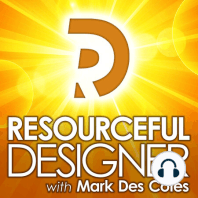37 min listen

Stop Treating Design As A Commodity - RD115
FromResourceful Designer: Strategies for running a graphic design business
Stop Treating Design As A Commodity - RD115
FromResourceful Designer: Strategies for running a graphic design business
ratings:
Length:
42 minutes
Released:
Apr 6, 2018
Format:
Podcast episode
Description
Design should not be a commodity. I recently saw a conversation in a Facebook group discussing price lists on design websites. The consensus was that including fixed or package prices on your site diminishes the value of your services as a designer. This got me thinking. Are designers who include price lists positioning themselves as a commodity? What is a commodity? Let me share three definitions of a commodity that I found online. A commodity is a physical substance, which is interchangeable with another product of the same type. A commodity is a good or service whose wide availability typically leads to smaller profit margins and diminishes the importance of factors other than price. A commodity is a good for which there is demand, but which is supplied without qualitative differentiation across a market. Do any of those pertain to design? Are the designs you create easily interchangeable with designs from other designers? Are the services you offer so widely available from other designers that it diminishes the importance of your skills on every level other than price? Are the services you provide without qualitative differentiation from those of other designers? If you answered yes to any of those questions then maybe you’ve positioned yourself as a commodity. If you have, I’m telling you right now that you need to change the way you think about your skills and your services. Especially if you offer your services as “package deals” or fixed prices based on the services you provide because all that does is diminish the value you bring to your clients. What is Design? Without getting too philosophical, design is simply a solution to a problem. Clients come to you because they have a problem to solve. They need an identity for their business. They have a product they need to market. They need to generate leads, they need to increase awareness for their brand, they need to convert sales. These are all problems your clients face. Your job as a designer is finding the most appropriate solution to those problems. You know the saying “think outside the box”? That’s where you are, and it's why clients hire you. Because you are “outside their box”. You have a different perspective then they do about their business, and they are looking to you for solutions to their problems. There’s a catch. When it comes to design, there is no one solution. Every designer out there will come up with their unique solution to any giving problem. That means that the solutions vary in quality and price depending on what designer a client chooses. It’s a case of “you get what you pay for”. Back in episode 71 of the podcast, I talked about Good Design, Quick Design or Cheap design and how you can only offer two at a time to a client. How are you supposed to provide solutions to your client’s unique problems if you limit yourself to the cost of a predefined design package? When you do, you’ve already chosen one of the three options, cheap design. Design should be a consultancy process. As a designer, your job is not to do what the client asks you to do. Your job is to get to know your client, understand their business, find out what their goals are, study their products, learn their process. Once you know everything you need to know about your client, your job then shifts to providing designs to your client that specifically addresses their problem. Making a visually pleasing website that’s also user-friendly, or making a brochure that stands out amongst the rest is icing on the cake. It’s a byproduct of everything you do for your clients. Your primary job should always be to help your clients succeed in their goals, whether that’s generating leads, or generating conversions. You do that by using your skills as a designer to help your clients. Clients are not hiring you for a logo, a brochure or a website. They may think that’s why they are hiring you. But in fact, they are hiring you for your knowledge, your experience and your ability to help them wi
Released:
Apr 6, 2018
Format:
Podcast episode
Titles in the series (100)
Dealing With Photographers-Brett Gilmour Interview - RD003: Dealing With Photographers Interview with Brett Gilmour In this episode of Resourceful Designer I'm joined by award winning photographer Brett Gilmour as we discuss things to help designers when dealing with photographers. Brett specializes in... by Resourceful Designer: Strategies for running a graphic design business